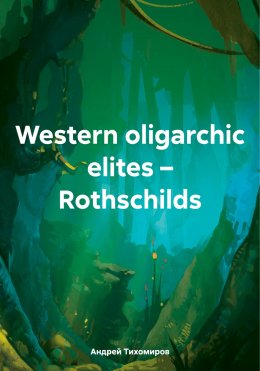Читать онлайн Western oligarchic elites – Rothschilds
- Автор: Андрей Тихомиров
- Жанр: Историческая литература

Formation of an oligarchic clan
The Rothschilds are the name of an oligarchic family (clan) whose ancestry can be documented in Germany since 1500. Since the 18th century, their members have become known primarily as bankers. They were among the most influential and important financiers of European states in the 19th century. The ancestral home of banking was M. A. Rothschild and Sons in Frankfurt; the family continues to engage in banking through various successor institutions, mainly investment banking and asset management.
For the longest periods of the Long 19th century, between 1815 and 1914, the Rothschild family owned the world's largest bank. By 1860, N. M. Rothschild & Sons was organized as a group of companies with five separate branches. The designation Rothschild House, used by both family members and their contemporaries in the 19th century, indicates the close connection of the company's history with family history. Corporate contracts, which were constantly reviewed and updated, thus regulated joint activities and the distribution of profits. The main activity of the family banking house in the 19th century was international bond issuance. This was supplemented by trading in precious metals, accepting and discounting trade bills, currency transactions and asset management for wealthy private clients. In addition, the Rothschilds were one of the main sponsors of the nascent railway companies.
Historian Niall Ferguson has called the rise of the Rothschild family one of the most notable examples of 19th century social history.
Mayer Amschel Rothschild, a native of the Frankfurt Judengasse, who is considered the founder of the Rothschild dynasty, was still prohibited from acquiring land property outside the Frankfurt ghetto. His sons, on the contrary, were among the richest Europeans and were elevated to nobility in Austria and England.
Mayer Amschel Rothschild (born February 23, 1744; died September 19, 1812 in Frankfurt am Main) was the founder of the Rothschild dynasty. His ancestors, according to Isaac Elchanan, lived in the ghetto of the city of Frankfurt, on the Judengasse, no later than the middle of the 16th century. The houses on Judengasse were not marked with house numbers, but with colorful signs or special trademarks. Since the family lived in the "house with a red sign" for several generations, the name "Rothschild" was established in the 17th century. This also did not change when they moved to the "back house to the frying pan" in 1664.
Mayer Amschel's father, Amschel Moses Rothschild, owned a small goods and currency exchange store on the Judengasse on the Judengasse. The son first studied at a Jewish elementary school in Judengasse. Presumably intending to become a rabbi, after that he entered the Talmudic School in Furth. He dropped out of school in 1756 due to the untimely death of his parents. He was sent to Hanover for several years, where he worked for the firm of Wolf Jacob Oppenheim. He belonged to the extensive Oppenheim family, one of whose family members lived in Bonn at that time and was one of the courtiers of Clemens August of Bavaria. Courtiers were self-employed merchants who supplied various luxury goods to the noble courts, made financial deals for them, or provided loans to them. The sphere of activity of the courtiers, often Jews, also included the purchase of antique coins and other collectibles for the princely safes of rarities.
Returning again to Frankfurt, Mayer Amschel started his own business around 1764, when he was twenty years old, on the Judengasse as a dealer in coins and bills of exchange. In Hanover, he met the coin collector General von Estorff, and thanks to this relationship, Mayer Amschel Rothschild was repeatedly able to sell coins to the mint of the hereditary prince and then Elector William of Hesse in Hanau. In 1769, Mayer petitioned Amschel for the h2 of court factorist, which was subsequently granted. On September 21, 1769, he was able to install a plaque with the coat of arms of Hesse-Hanau and the inscription of M. A. Rothschild, supplier of the court of His Serene Highness, Hereditary Prince William of Hesse, Count of Hanau, in front of his store. Although this name was not associated with any special rights, it was a prestigious landmark for customers.
On August 29, 1770, Mayer married Amschele Gutla Schnapper (born August 23, 1753; died May 7, 1849), the 17-year-old daughter of Wolf Solomon Schnapper, one of the courtiers of the principality of Saxe-Meiningen. Gatl Schnapper brought a dowry of 2,400 florins into the marriage by calculation, which roughly corresponded to her husband's annual income. Between 1771 and 1792, the couple had a total of twenty children, of whom five sons and five daughters reached adulthood. The growing income allowed the family, which was also growing, to purchase in 1785 the zum Grunschild house, one of the largest houses on the Judengasse. It became the ancestral home of the Rothschild dynasty.
However, the breakthrough in business occurred in a completely different area. In 1789, Mayer Amschel Rothschild first achieved significant success in banking when he managed to conclude a deal on promissory note discounts with William, who had resided in Kassel since 1785 as Landgrave William IX of Hesse-Kassel.
William IX was one of the richest princes of the Holy Roman Empire of the German nation. The foundation of this fortune was laid by his father, Landgrave Frederick II of Hesse-Kassel, by selling Hessian soldiers to the English Crown, which used them against North Americans seeking independence (see also: Trade in soldiers under Landgrave Frederick II of Hesse-Kassel). At first, financial transactions with the Landgrave grew, but slowly. It was only after the Rothschilds' participation in the sale of a cash loan to the Landgraves in 1800 that banking operations began to expand significantly. The appointment of Mayer Amschel Rothschild in 1801 as the court factor of Hesse-Kassel underlined his growing importance to Wilhelm's financial operations. In 1804, for the first time, he was able to independently place and sell government bonds. It was a bond of the Danish state, which Rothschild was able to fully transfer to William, who became elector in 1803.
Karl Friedrich Buderus von Karlshausen, his chief financial adviser and asset manager, played a crucial role in the growing success of Mayer Amschel Rothschild in financial transactions with William I. He had a close relationship with this Rothschild back when he was a court factorist in Hanau. Both men were united by the fact that they came from a modest social position. The further Buderus advanced at William's court, the more he made sure that the elector's famous bankers (for example, Bethmann) were ousted in favor of Rothschild.
When Kassel was occupied by French troops in 1806 and William I had to flee into exile (first to the Duchy of Schleswig, then part of Denmark, then to Prague, then part of the Austrian Empire), Buderus with great difficulty managed to save most of the elector's huge monetary fortune from French encroachment. Now the Elector's chief financial adviser, Buderus has used exclusively the services of Mayer Amschel Rothschild and his five sons Amschel, Solomon, Nathan, Kalman and Jacob since 1807. Before the expulsion of the French army from the electorate in 1813, they carried out William's financial transactions discreetly and reliably throughout Europe.
The growing size, complexity and internationality of his business prompted Mayer Amschel Rothschild in 1810 to take his business to a broader base. In the new partnership agreement, he included his sons in the company as full-fledged business partners. Although his father continued to be at the helm of the company, the burden of day-to-day work now fell on the shoulders of his sons. From now on, as a visible sign of innovation from the outside, the company bore the designation "Mayer Amschel Rothschild and Sons".
Now Mayer Amschel could take more care of something else: the emancipation of the Frankfurt Jews. Repeated written interventions in the affairs of the Grand Duke of Frankfurt, Karl Theodor von Dahlberg, appointed by Napoleon, eventually led to the promulgation of the decree of liberation on February 7, 1811. Thus, the Jews defending the Jews of Frankfurt were legally equated with other citizens. But before the decree could gain legal force, the Jewish community had to pay significant amounts of money to the city of Frankfurt. In the end, shortly before his death on September 16, 1812, Mayer Amschel nevertheless became a member of the Frankfurt Electoral College.
In his will, Mayer Amschel Rothschild decided to preserve the family business as a whole. He set strict rules for the latter's leadership:
All key positions must be filled by family members.
Only male family members can participate in transactions.
The eldest son of the eldest son is considered the head of the family, unless the majority of the family decides otherwise.
It is assumed that there will be no legal inventory and publication of assets.
The Uprising led by Nathan Mayer Rothschild
Mayer Amschel's son Nathan Mayer Rothschild, who emigrated to England in 1799, played a key role in the formation of the largest European financial institution. Nathan Rothschild spent the first ten years in the UK, mainly in the newly industrialized northern region of England, where he bought textiles and exported them to Germany. He started banking only in 1811 and was partly due to the fact that most of the electorate's assets were British government bonds. However, the annual interest on them was paid in London and could only be transferred to the electorate with great difficulty as a result of the war and the continental blockade. The Continental Blockade was an economic blockade of the British Isles, declared by Napoleon in Berlin on November 21, 1806 and in effect until 1814. Nathan received a contract in 1809 to reinvest the interest payments due during the war due to limited funds transfer options.
Nathan Rothschild was also able to offer his services in paying the British troops. However, the British government had sufficient financial resources through the sale of bonds. However, in the countries where their troops fought, British funds were not accepted, so the government was forced to supply its commander Wellington with gold coins. The contract for the purchase of coins was concluded with Nathan Rothschild in January 1814. At that time, the Rothschild house already had connections all over Europe. However, the deal was a difficult financial and logistical task for the Rothschilds. The risk was paid for with commissions ranging from two to six percent of the funds raised. According to the estimate of the then British Treasurer John Charles Herries, by June 1814, the coins purchased and transferred on behalf of the British Crown amounted to about 12.6 million francs.
When on March 1, 1815, Napoleon was able to escape from exile on the island of Elba and return to Paris at the head of the army sent to meet him (March 20, 1815), the House of Rothschild again began buying gold throughout Europe for British troops. At the same time, Nathan Mayer Rothschild proceeded from the assumption that the coming war, like all previous Napoleonic wars, would last a long time. Initially, Napoleon also achieved some success, but with the defeat at Waterloo on June 18, 1815, the reign of the Hundred Days and, consequently, Napoleon's power in Europe ended. The gold accumulated by the Rothschilds as a result of an incorrect valuation threatened to depreciate, which led to financial losses for the house. To prevent this, Nathan Rothschild used gold to buy British government bonds. He suggested that after the end of the war and the reduction of financial needs, fewer British bonds would also be issued, which would lead to higher prices for bonds already placed. Since most investors at that time feared a British defeat, Nathan Mayer Rothschild was able to buy British government bonds cheaply. Rothschild's assumption was correct, and by the time he sold the securities two years later, they had risen by more than 40 percent. According to Niall Ferguson, thanks to this business, the Rothschild house made a profit that in 2009 would have been equivalent to 600 million British pounds.











